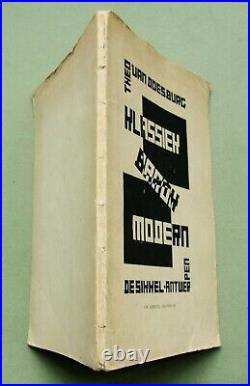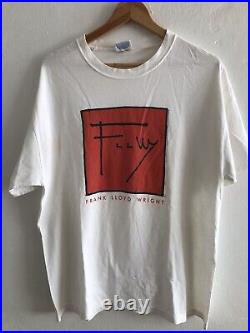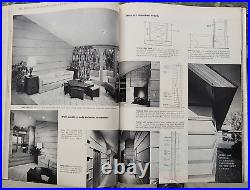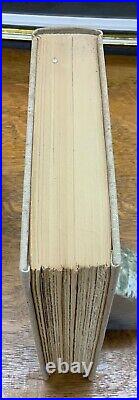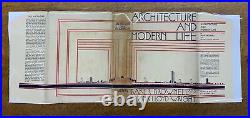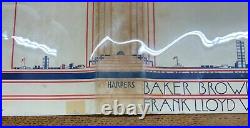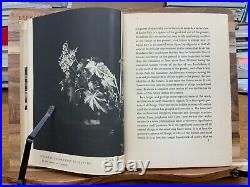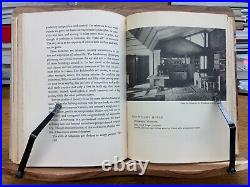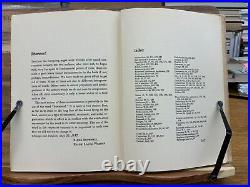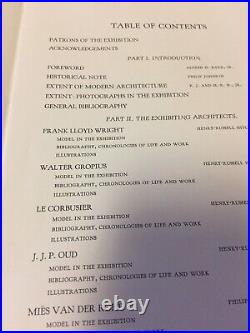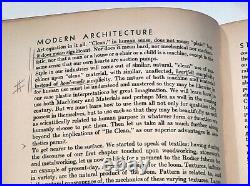Posts tagged modern
This is an original December 1956 House & Home magazine. Not a reproduction or digital copy. Inside pages clean and bright. No missing or torn or loose pages. Tight binding and good spine. Front cover illustration is good but edge wear and creases. Ex-library but ink stamp upper left corner of cover is only indication of having been in a library. A good copy of a 65-year-old architecture book. House & Home was a leading journal among contractors and building professionals. Each issue featured house designs, technical discussions, building trade news, and editorials. This issue discussed prefabrication in the housing industry but is most noted for the cover photo & article on Frank Lloyd Wright design for prefabricated Erdman Homes. Editorials and advertisements typical of a 1950′s architecture home building magazine.
Architecture and Modern Life. By Baker Brownell and Frank Lloyd Wright. Harper & Brothers Publishers, New York and London, 1938, Stated Second Edition. A complete work with all plates, 339 pp, 9 x 6.5, 8vo. Dust jacket is clipped on all corners (including original price). Head and tail of dust jacket’s spine exhibit small tears; spine toned & soiled from normal shelf-wear. Piece of clear tape found on dust jacket’s rear cover, bottom edge. Small chip present on top edge of dust jacket’s front cover. Tan cloth boards lightly scuffed at edges and corners. Head and tail of spine bumped. Gilt lettering on spine overall bright and clean. Previous ownership bookplate found on front paste-down: Maurice Robert des Marais. Toning exhibited in front and rear gutters. Binding beginning to split at title page. Normal age-related toning throughout text-block; mostly to edges of leaves. Pencil marginalia found on bottom edge of rear paste-down. Binding intact; front hinge fragile. Please see photos and ask questions, if any, before purchasing. Frank Lloyd Wright Sr. (1867 – 1959) was an American architect, designer, writer, and educator. He designed more than 1,000 structures over a creative period of 70 years. Wright played a key role in the architectural movements of the twentieth century, influencing architects worldwide through his works and mentoring hundreds of apprentices in his Taliesin Fellowship. Wright believed in designing in harmony with humanity and the environment, a philosophy he called organic architecture. Wright was a pioneer of what came to be called the Prairie School movement of architecture and also developed the concept of the Usonian home in Broadacre City, his vision for urban planning in the United States. He also designed original and innovative offices, churches, schools, skyscrapers, hotels, museums, and other commercial projects. Wright-designed interior elements (including leaded glass windows, floors, furniture and even tableware) were integrated into these structures. He wrote several books and numerous articles and was a popular lecturer in the United States and in Europe. Baker Brownell (1887 – 1965) was an American philosopher. Brownell was born in St. Charles, Illinois, the fifth of six children of Eugene A. And Esther Burr Baker Brownell. He grew up in St. Charles, where he graduated from St. Among his trips were a tour of the Galapagos Islands and an expedition to Cocos Island as the guest of his friend Commander E. The Chairman of the Zenith Corporation; a six-month sojourn in the interior of Guatemala ; a summer in Tahiti ; a trip to Isle Royale, Michigan, as a member of the Isle Royale Archeological Expedition; and various cruises in the Caribbean. With Frank Lloyd Wright in 1937, he wrote Architecture and Modern Life ; and in 1939 he wrote Art in Action, explaining his views about the humanities. With RARE intact dust jacket!
1932 for the International Exhibibition. The size is approx. 7-1/2″x10″x1 & it has 200 pages filled with the works of architects such as: Frank Lloyd Wright, Walter Gropius, Mies van der Rohe, Le Corbusier, Richard Neutra and so many more. Philip Johnson is also mentioned. This soft cover book is in pretty good condition considering its age. Many difficult architectural problems are touched upon in the exhibition, such as the private house, the school, apartment houses, both urban and suburban, the church, the factory, the department store, the club, the college dormitory. More important than these is the problem of low-cost housing. Make sure that you look at all photos, as this amazing soft cover book would make a great addition to your architecture collection.










